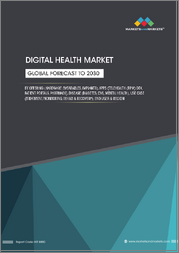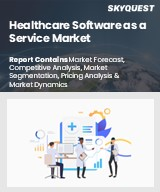
|
시장보고서
상품코드
1457954
세계의 환자 소개 관리 소프트웨어 시장 : 시장 규모, 점유율 분석, 산업 매출 추정 및 수요 예측(-2030년)Patient Referral Management Software Market Size and Share Analysis by Component, Type, Mode of Delivery, End User - Global Industry Revenue Estimation and Demand Forecast to 2030 |
||||||
세계의 환자 소개 관리 소프트웨어(Patient Referral Management Software) 시장은 2023년에는 95억 9,830만 달러였으며, 17.9%의 CAGR로 추이하며 성장하여, 2030년에는 302억 2,120만 달러에 달할 것으로 예상됩니다.
이 산업의 성장 배경은 각국의 노인 인구의 급증, 지속적인 기술 개선, 의료 제도에 대한 IT 솔루션의 도입을 촉진하는 정부의 이니셔티브입니다.
또한, 활동 스케줄링의 정확성, 의료 시설 접근성 향상, 일상 업무의 간소화, 데이터 관리의 생산성 등이 업계의 지속적인 성장을 가능하게 하는 소프트웨어의 주요 이점입니다.
부문 분석
2023년에는 소프트웨어 범주가 큰 점유율을 차지했으며, 지난 10년간 더 빠른 속도로 발전할 것으로 보입니다. 이는 이러한 소프트웨어가 의료 시설과 시설의 일상 업무 프로세스에 효율성과 정확성 수준을 제공하기 때문입니다.
인바운드 카테고리는 향후 몇 년동안 17.9%의 빠른 속도로 발전할 것으로 예상됩니다.
병원과 전문센터는 디지털화를 통해 다양한 출처에서 엄청난 수의 인바운드 소개를 받게 되었습니다. 그러므로, 처리 시간의 단축과 의료 종사자 간의 커뮤니케이션 강화가 필수가 됩니다.
클라우드 기반 범주는 향후 몇 년동안 업계의 큰 점유율을 차지할 것으로 보입니다. 이는 하드웨어 설정에 필요한 자본 비용 최소화, 데이터 유출 방지, 스토리지 용량 확장성 향상, 데이터 보안 등 이유로 클라우드 기반 솔루션의 인기가 높아지고 있기 때문입니다.
북미가 최대 점유율을 차지
북미는 지난 10년간 업계를 선도해 나갈 것으로 보입니다. 또한 이 지역은 지난 10년간 17.8%의 CAGR로 성장할 전망입니다. 이 대륙에서는 원격 의료 및 전자 처방(의료 서비스에 원격 액세스하기 위한 디지털 데이터 사용)과 같은 솔루션에 대한 의식과 수용이 높아지고 있습니다.
아시아 태평양은 향후 수년간 18.3%라는 가장 빠른 속도로 진보할 것으로 보입니다. 이 배경은 노인 인구의 지속적인 증가와 의료 제도의 다른 다양한 혁신 기술의 통합과 함께 디지털화를 통해 더 큰 관리를 제공하기 위한 정부의 이니셔티브입니다.
전 세계 환자 소개 관리 소프트웨어(Patient Referral Management Software) 시장을 분석했으며, 시장의 기본 구조/최신 상황/주요 촉진 및 억제 요인/전 세계 및 지역별 및 주요 국가 시장 규모 동향 전망(금액 기준, 2017-2030년)/컴포넌트별·유형별·제공 모드별·최종 사용자별 상세 동향/현재 시장 경쟁 구도/주요 기업 프로파일 등 정보를 전해드립니다.
목차
제1장 조사 범위
제2장 조사 방법
제3장 주요 요약
제4장 시장 지표
제5장 산업 전망
- 시장 역학
- 동향
- 성장 촉진 요인
- 억제 요인/과제
- 성장 촉진 요인/억제 요인의 영향 분석
- COVID-19의 영향
- Porter's Five Forces 분석
제6장 시장
- 개요
- 시장 매출 : 컴포넌트별(2017-2030년)
- 시장 매출 : 유형별(2017-2030년)
- 시장 매출 : 제공 모드별(2017-2030년)
- 시장 매출 : 최종 사용자별(2017-2030년)
- 시장 매출 : 지역별(2017-2030년)
제7장 북미 시장
- 개요
- 시장 매출 : 컴포넌트별(2017-2030년)
- 시장 매출 : 유형별(2017-2030년)
- 시장 매출 : 제공 모드별(2017-2030년)
- 시장 매출 : 최종 사용자별(2017-2030년)
- 시장 매출 : 국가별(2017-2030년)
제8장 유럽 시장
제9장 아시아 태평양 시장
제10장 남미 시장
제11장 중동 및 아프리카(MEA) 시장
제12장 미국 시장
- 개요
- 시장 매출 : 컴포넌트별(2017-2030년)
- 시장 매출 : 유형별(2017-2030년)
- 시장 매출 : 제공 모드별(2017-2030년)
- 시장 매출 : 최종 사용자별(2017-2030년)
제13장 캐나다 시장
제14장 독일 시장
제15장 프랑스 시장
제16장 영국 시장
제17장 이탈리아 시장
제18장 스페인 시장
제19장 일본 시장
제20장 중국 시장
제21장 인도 시장
제22장 호주 시장
제23장 한국 시장
제24장 브라질 시장
제25장 멕시코 시장
제26장 사우디아라비아 시장
제27장 남아프리카 시장
제28장 아랍에미리트(UAE) 시장
제29장 경쟁 구도
- 시장 진출기업 및 제공 제품 및 서비스 목록
- 주요 기업의 경쟁 벤치마킹
- 주요 기업의 제품 벤치마킹
- 최근의 전략 전개 상황
제30장 기업 프로파일
- ReferralMD
- Kyruus
- eHealth Technologies
- BlockitNow Inc.
- CarePort Health
- Conifer Health Solutions
- Optum Inc.
- Netsmart Technologies Inc.
- ReferWell
- HealthViewX
- Lightbeam Health Solutions
제31장 부록
LYJ 24.04.16The patient referral management software market was USD 9,598.3 million in 2023, which will rise to USD 30,221.2 million, with a 17.9% CAGR, by 2030.
The growth of this industry is because of the surging elderly population in different nations, constant technological improvements, and initiatives by governments to promote healthcare systems to utilize IT solutions.
Moreover, precision in activity scheduling, enhancement in medical facilities access, streamlining of daily operations, and productivity in data management are some key benefits of such software that can enable the industry's continuous growth.
Technological Advancement is Key Driver
In the wake of technological improvements, including the acceptance of electronic prescriptions, electronic health records, and cloud-based solutions, the digitalization of different medical processes has become quite widespread.
For effective patient referral management, software & services have been developed by many HIT firms, and healthcare establishments are employing the same for running their regular procedures in a much more systematized means, with less possibility of human error.
Referral cycles can be properly managed easily from start to end with such software as well as associated services. Monitoring the complete treatment progress and delivering ideal medical resources at the right time are some of the features that can assist establishments in significantly enhancing patient satisfaction and referral network effectiveness.
Segmentation Analysis
In 2023, the software category was a significant contributor to the industry, and it will advance at a faster rate during this decade. This is because of the efficiency and accuracy levels that such software offers to healthcare facilities and establishments for their day-to-day business processes.
The inbound category is expected to advance at a faster rate, of 17.9%, in the years to come.
Hospitals as well as specialty centers receive an enormous number of inbound referrals via different sources, because of digitalization.
Therefore, less processing duration and greater communication among medical professionals become imperative.
The cloud-based category will account for a larger share of the industry in the years to come. This is because of the increasing popularity of cloud-based solutions because of their minimal capital costs for hardware setup, prevention of data loss, enhanced scalability of the storage capacity, and data security.
North America to Hold Largest Share
North America will lead the industry throughout this decade. Moreover, the region will also advance at a 17.8% CAGR during this decade. The consciousness and acceptance of solutions like telehealth and electronic prescribing, which comprises the use of digital data for remote access to healthcare services, is increasing in this continent.
APAC is likely to advance at the fastest rate, of 18.3%, in the coming years. This is because of the constant increase in the elderly population and the government initiatives for delivering greater care via digitalization along with the integration of various other innovative technologies in healthcare systems.
Competitive Landscape
Major players in this industry are making significant investments to expand their business and enhance their offerings. Also, they are entering into partnerships to provide their products and services to more audiences and funding to add more features for automating the processes for all end users and offering updated versions of the software.
With the continuous technological improvements, coupled with the rising aging population, the patient referral management software industry will continuously grow in the coming years.
Table of Contents
Chapter 1. Research Scope
- 1.1. Research Objectives
- 1.2. Market Definition
- 1.3. Analysis Period
- 1.4. Market Size Breakdown by Segments
- 1.4.1. Market size breakdown, by component
- 1.4.2. Market size breakdown, by type
- 1.4.3. Market size breakdown, by mode of delivery
- 1.4.4. Market size breakdown, by end user
- 1.4.5. Market size breakdown, by region
- 1.4.6. Market size breakdown, by country
- 1.5. Market Data Reporting Unit
- 1.5.1. Value
- 1.6. Key Stakeholders
Chapter 2. Research Methodology
- 2.1. Secondary Research
- 2.1.1. Paid
- 2.1.2. Unpaid
- 2.1.3. P&S Intelligence database
- 2.2. Primary Research
- 2.3. Market Size Estimation
- 2.4. Data Triangulation
- 2.5. Currency Conversion Rates
- 2.6. Assumptions for the Study
- 2.7. Notes and Caveats
Chapter 3. Executive Summary
Chapter 4. Market Indicators
Chapter 5. Industry Outlook
- 5.1. Market Dynamics
- 5.1.1. Trends
- 5.1.2. Drivers
- 5.1.3. Restraints/challenges
- 5.1.4. Impact analysis of drivers/restraints
- 5.2. Impact of COVID-19
- 5.3. Porter's Five Forces Analysis
- 5.3.1. Bargaining power of buyers
- 5.3.2. Bargaining power of suppliers
- 5.3.3. Threat of new entrants
- 5.3.4. Intensity of rivalry
- 5.3.5. Threat of substitutes
Chapter 6. Global Market
- 6.1. Overview
- 6.2. Market Revenue, by Component (2017-2030)
- 6.3. Market Revenue, by Type (2017-2030)
- 6.4. Market Revenue, by Mode of Delivery (2017-2030)
- 6.5. Market Revenue, by End User (2017-2030)
- 6.6. Market Revenue, by Region (2017-2030)
Chapter 7. North America Market
- 7.1. Overview
- 7.2. Market Revenue, by Component (2017-2030)
- 7.3. Market Revenue, by Type (2017-2030)
- 7.4. Market Revenue, by Mode of Delivery (2017-2030)
- 7.5. Market Revenue, by End User (2017-2030)
- 7.6. Market Revenue, by Country (2017-2030)
Chapter 8. Europe Market
- 8.1. Overview
- 8.2. Market Revenue, by Component (2017-2030)
- 8.3. Market Revenue, by Type (2017-2030)
- 8.4. Market Revenue, by Mode of Delivery (2017-2030)
- 8.5. Market Revenue, by End User (2017-2030)
- 8.6. Market Revenue, by Country (2017-2030)
Chapter 9. APAC Market
- 9.1. Overview
- 9.2. Market Revenue, by Component (2017-2030)
- 9.3. Market Revenue, by Type (2017-2030)
- 9.4. Market Revenue, by Mode of Delivery (2017-2030)
- 9.5. Market Revenue, by End User (2017-2030)
- 9.6. Market Revenue, by Country (2017-2030)
Chapter 10. LATAM Market
- 10.1. Overview
- 10.2. Market Revenue, by Component (2017-2030)
- 10.3. Market Revenue, by Type (2017-2030)
- 10.4. Market Revenue, by Mode of Delivery (2017-2030)
- 10.5. Market Revenue, by End User (2017-2030)
- 10.6. Market Revenue, by Country (2017-2030)
Chapter 11. MEA Market
- 11.1. Overview
- 11.2. Market Revenue, by Component (2017-2030)
- 11.3. Market Revenue, by Type (2017-2030)
- 11.4. Market Revenue, by Mode of Delivery (2017-2030)
- 11.5. Market Revenue, by End User (2017-2030)
- 11.6. Market Revenue, by Country (2017-2030)
Chapter 12. U.S. Market
- 12.1. Overview
- 12.2. Market Revenue, by Component (2017-2030)
- 12.3. Market Revenue, by Type (2017-2030)
- 12.4. Market Revenue, by Mode of Delivery (2017-2030)
- 12.5. Market Revenue, by End User (2017-2030)
Chapter 13. Canada Market
- 13.1. Overview
- 13.2. Market Revenue, by Component (2017-2030)
- 13.3. Market Revenue, by Type (2017-2030)
- 13.4. Market Revenue, by Mode of Delivery (2017-2030)
- 13.5. Market Revenue, by End User (2017-2030)
Chapter 14. Germany Market
- 14.1. Overview
- 14.2. Market Revenue, by Component (2017-2030)
- 14.3. Market Revenue, by Type (2017-2030)
- 14.4. Market Revenue, by Mode of Delivery (2017-2030)
- 14.5. Market Revenue, by End User (2017-2030)
Chapter 15. France Market
- 15.1. Overview
- 15.2. Market Revenue, by Component (2017-2030)
- 15.3. Market Revenue, by Type (2017-2030)
- 15.4. Market Revenue, by Mode of Delivery (2017-2030)
- 15.5. Market Revenue, by End User (2017-2030)
Chapter 16. U.K. Market
- 16.1. Overview
- 16.2. Market Revenue, by Component (2017-2030)
- 16.3. Market Revenue, by Type (2017-2030)
- 16.4. Market Revenue, by Mode of Delivery (2017-2030)
- 16.5. Market Revenue, by End User (2017-2030)
Chapter 17. Italy Market
- 17.1. Overview
- 17.2. Market Revenue, by Component (2017-2030)
- 17.3. Market Revenue, by Type (2017-2030)
- 17.4. Market Revenue, by Mode of Delivery (2017-2030)
- 17.5. Market Revenue, by End User (2017-2030)
Chapter 18. Spain Market
- 18.1. Overview
- 18.2. Market Revenue, by Component (2017-2030)
- 18.3. Market Revenue, by Type (2017-2030)
- 18.4. Market Revenue, by Mode of Delivery (2017-2030)
- 18.5. Market Revenue, by End User (2017-2030)
Chapter 19. Japan Market
- 19.1. Overview
- 19.2. Market Revenue, by Component (2017-2030)
- 19.3. Market Revenue, by Type (2017-2030)
- 19.4. Market Revenue, by Mode of Delivery (2017-2030)
- 19.5. Market Revenue, by End User (2017-2030)
Chapter 20. China Market
- 20.1. Overview
- 20.2. Market Revenue, by Component (2017-2030)
- 20.3. Market Revenue, by Type (2017-2030)
- 20.4. Market Revenue, by Mode of Delivery (2017-2030)
- 20.5. Market Revenue, by End User (2017-2030)
Chapter 21. India Market
- 21.1. Overview
- 21.2. Market Revenue, by Component (2017-2030)
- 21.3. Market Revenue, by Type (2017-2030)
- 21.4. Market Revenue, by Mode of Delivery (2017-2030)
- 21.5. Market Revenue, by End User (2017-2030)
Chapter 22. Australia Market
- 22.1. Overview
- 22.2. Market Revenue, by Component (2017-2030)
- 22.3. Market Revenue, by Type (2017-2030)
- 22.4. Market Revenue, by Mode of Delivery (2017-2030)
- 22.5. Market Revenue, by End User (2017-2030)
Chapter 23. South Korea Market
- 23.1. Overview
- 23.2. Market Revenue, by Component (2017-2030)
- 23.3. Market Revenue, by Type (2017-2030)
- 23.4. Market Revenue, by Mode of Delivery (2017-2030)
- 23.5. Market Revenue, by End User (2017-2030)
Chapter 24. Brazil Market
- 24.1. Overview
- 24.2. Market Revenue, by Component (2017-2030)
- 24.3. Market Revenue, by Type (2017-2030)
- 24.4. Market Revenue, by Mode of Delivery (2017-2030)
- 24.5. Market Revenue, by End User (2017-2030)
Chapter 25. Mexico Market
- 25.1. Overview
- 25.2. Market Revenue, by Component (2017-2030)
- 25.3. Market Revenue, by Type (2017-2030)
- 25.4. Market Revenue, by Mode of Delivery (2017-2030)
- 25.5. Market Revenue, by End User (2017-2030)
Chapter 26. Saudi Arabia Market
- 26.1. Overview
- 26.2. Market Revenue, by Component (2017-2030)
- 26.3. Market Revenue, by Type (2017-2030)
- 26.4. Market Revenue, by Mode of Delivery (2017-2030)
- 26.5. Market Revenue, by End User (2017-2030)
Chapter 27. South Africa Market
- 27.1. Overview
- 27.2. Market Revenue, by Component (2017-2030)
- 27.3. Market Revenue, by Type (2017-2030)
- 27.4. Market Revenue, by Mode of Delivery (2017-2030)
- 27.5. Market Revenue, by End User (2017-2030)
Chapter 28. U.A.E. Market
- 28.1. Overview
- 28.2. Market Revenue, by Component (2017-2030)
- 28.3. Market Revenue, by Type (2017-2030)
- 28.4. Market Revenue, by Mode of Delivery (2017-2030)
- 28.5. Market Revenue, by End User (2017-2030)
Chapter 29. Competitive Landscape
- 29.1. List of Market Players and their Offerings
- 29.2. Competitive Benchmarking of Key Players
- 29.3. Product Benchmarking of Key Players
- 29.4. Recent Strategic Developments
Chapter 30. Company Profiles
- 30.1. ReferralMD
- 30.1.1. Business overview
- 30.1.2. Product and service offerings
- 30.1.3. Key financial summary
- 30.2. Kyruus
- 30.2.1. Business overview
- 30.2.2. Product and service offerings
- 30.2.3. Key financial summary
- 30.3. eHealth Technologies
- 30.3.1. Business overview
- 30.3.2. Product and service offerings
- 30.3.3. Key financial summary
- 30.4. BlockitNow Inc.
- 30.4.1. Business overview
- 30.4.2. Product and service offerings
- 30.4.3. Key financial summary
- 30.5. CarePort Health
- 30.5.1. Business overview
- 30.5.2. Product and service offerings
- 30.5.3. Key financial summary
- 30.6. Conifer Health Solutions
- 30.6.1. Business overview
- 30.6.2. Product and service offerings
- 30.6.3. Key financial summary
- 30.7. Optum Inc.
- 30.7.1. Business overview
- 30.7.2. Product and service offerings
- 30.7.3. Key financial summary
- 30.8. Netsmart Technologies Inc.
- 30.8.1. Business overview
- 30.8.2. Product and service offerings
- 30.8.3. Key financial summary
- 30.9. ReferWell
- 30.9.1. Business overview
- 30.9.2. Product and service offerings
- 30.9.3. Key financial summary
- 30.10. HealthViewX
- 30.10.1. Business overview
- 30.10.2. Product and service offerings
- 30.10.3. Key financial summary
- 30.11. Lightbeam Health Solutions
- 30.11.1. Business overview
- 30.11.2. Product and service offerings
- 30.11.3. Key financial summary
Chapter 31. Appendix
- 31.1. Abbreviations
- 31.2. Sources and References
- 31.3. Related Reports



















